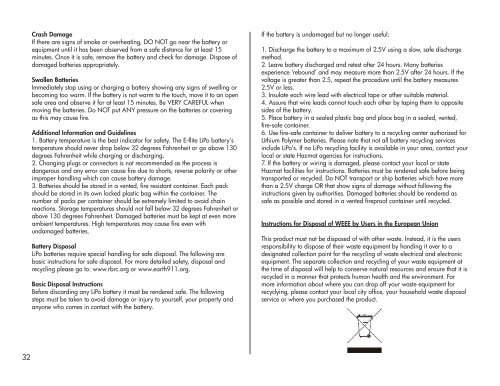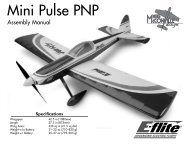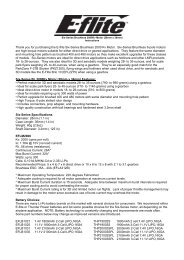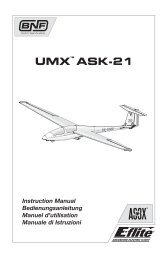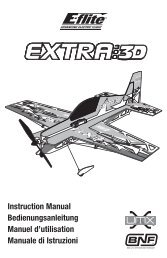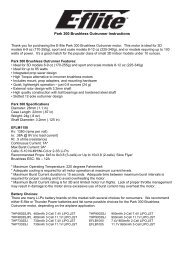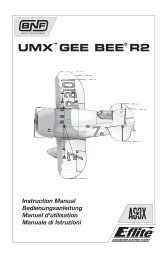Crash DamageIf there are signs of smoke or overheating, DO NOT go near the battery orequipment until it has been observed from a safe distance for at least 15minutes. Once it is safe, remove the battery and check for damage. Dispose ofdamaged batteries appropriately.Swollen BatteriesImmediately stop using or charging a battery showing any signs of swelling orbecoming too warm. If the battery is not warm to the touch, move it to an opensafe area and observe it for at least 15 minutes. Be VERY CAREFUL whenmoving the batteries. Do NOT put ANY pressure on the batteries or coveringas this may cause fire.Additional Information and Guidelines1. Battery temperature is the best indicator for safety. The E-<strong>flite</strong> LiPo battery’stemperature should never drop below 32 degrees Fahrenheit or go above 130degrees Fahrenheit while charging or discharging.2. Changing plugs or connectors is not recommended as the process isdangerous and any error can cause fire due to shorts, reverse polarity or otherimproper handling which can cause battery damage.3. Batteries should be stored in a vented, fire resistant container. Each packshould be stored in its own locked plastic bag within the container. Thenumber of packs per container should be extremely limited to avoid chainreactions. Storage temperatures should not fall below 32 degrees Fahrenheit orabove 130 degrees Fahrenheit. Damaged batteries must be kept at even moreambient temperatures. High temperatures may cause fire even withundamaged batteries.Battery DisposalLiPo batteries require special handling for safe disposal. The following arebasic instructions for safe disposal. For more detailed safety, disposal andrecycling please go to: www.rbrc.org or www.earth911.org.Basic Disposal InstructionsBefore discarding any LiPo battery it must be rendered safe. The followingsteps must be taken to avoid damage or injury to yourself, your property andanyone who comes in contact with the battery.If the battery is undamaged but no longer useful:1. Discharge the battery to a maximum of 2.5V using a slow, safe dischargemethod.2. Leave battery discharged and retest after 24 hours. Many batteriesexperience ‘rebound’ and may measure more than 2.5V after 24 hours. If thevoltage is greater than 2.5, repeat the procedure until the battery measures2.5V or less.3. Insulate each wire lead with electrical tape or other suitable material.4. Assure that wire leads cannot touch each other by taping them to oppositesides of the battery.5. Place battery in a sealed plastic bag and place bag in a sealed, vented,fire-safe container.6. Use fire-safe container to deliver battery to a recycling center authorized forLithium Polymer batteries. Please note that not all battery recycling servicesinclude LiPo’s. If no LiPo recycling facility is available in your area, contact yourlocal or state Hazmat agencies for instructions.7. If the battery or wiring is damaged, please contact your local or stateHazmat facilities for instructions. Batteries must be rendered safe before beingtransported or recycled. Do NOT transport or ship batteries which have morethan a 2.5V charge OR that show signs of damage without following theinstructions given by authorities. Damaged batteries should be rendered assafe as possible and stored in a vented fireproof container until recycled.Instructions for Disposal of WEEE by Users in the European UnionThis product must not be disposed of with other waste. Instead, it is the usersresponsibility to dispose of their waste equipment by handing it over to adesignated collection point for the recycling of waste electrical and electronicequipment. The separate collection and recycling of your waste equipment atthe time of disposal will help to conserve natural resources and ensure that it isrecycled in a manner that protects human health and the environment. Formore information about where you can drop off your waste equipment forrecyclying, please contact your local city office, your household waste disposalservice or where you purchased the product.32
AMA National Model Aircraft Safety CodeGENERAL1. A model aircraft shall be defined as a non-human-carrying device capableof sustained flight in the atmosphere. It shall not exceed limitations establishedin this code and is intended to be used exclusively for recreational orcompetition activity.2. The maximum takeoff weight of a model aircraft, including fuel, is 55pounds, except for those flown under the AMA Experimental Aircraft Rules.3. I will abide by this Safety Code and all rules established for the flying site Iuse. I will not willfully fly my model aircraft in a reckless and/or dangerousmanner.4. I will not fly my model aircraft in sanctioned events, air shows, or modeldemonstrations until it has been proven airworthy.5. I will not fly my model aircraft higher than approximately 400 feet aboveground level, when within three (3) miles of an airport without notifyingthe airport operator. I will yield the right-of-way and avoid flying in theproximity of full-scale aircraft, utilizing a spotter when appropriate.6. I will not fly my model aircraft unless it is identified with my name andaddress, or AMA number, inside or affixed to the outside of the model aircraft.This does not apply to model aircraft flown indoors.7. I will not operate model aircraft with metal-blade propellers or with gaseousboosts (other than air), nor will I operate model aircraft with fuels containingtetranitromethane or hydrazine.8. I will not operate model aircraft carrying pyrotechnic devices which explodeburn, or propel a projectile of any kind. Exceptions include Free Flight fuses ordevices that burn producing smoke and are securely attached to the modelaircraft during flight. Rocket motors up to a G-series size may be used,provided they remain firmly attached to the model aircraft during flight. Modelrockets may be flown in accordance with the National Model Rocketry SafetyCode; however, they may not be launched from model aircraft. Officiallydesignated AMAAir Show Teams (AST) are authorized to use devices andpractices as defined within the Air Show Advisory Committee Document.9. I will not operate my model aircraft while under the influence of alcohol orwithin eight (8) hours of having consumed alcohol.10. I will not operate my model aircraft while using any drug which couldadversely affect my ability to safely control my model aircraft.11. Children under six (6) years old are only allowed on a flightline or in aflight area as a pilot or while under flight instruction.12. When and where required by rule, helmets must be properly worn andfastened. They must be OSHA, DOT, ANSI, SNELL or NOCSAEapproved or comply with comparable standards.RADIO CONTROL1. All model flying shall be conducted in a manner to avoid over flight ofunprotected people.2. I will have completed a successful radio equipment ground-range checkbefore the first flight of a new or repaired model aircraft.3. I will not fly my model aircraft in the presence of spectators until I become aproficient flier, unless I am assisted by an experienced pilot.4. At all flying sites a line must be established, in front of which all flying takesplace. Only personnel associated with flying the model aircraft are allowed ator in front of the line. In the case of airshows demonstrations straight line mustbe established. An area away from the line must be maintained for spectators.Intentional flying behind the line is prohibited.5. I will operate my model aircraft using only radio-control frequenciescurrently allowed by the Federal Communications Commission (FCC). Onlyindividuals properly licensed by the FCC are authorized to operate equipmenton Amateur Band frequencies.6. I will not knowingly operate my model aircraft within three (3) miles of anypreexisting flying site without a frequency-management agreement. Afrequency-management agreement may be an allocation of frequencies foreach site, a day-use agreement between sites, or testing which determines thatno interference exists. A frequency-management agreement may exist betweentwo or more AMA chartered clubs, AMA clubs and individual AMA members,or individual AMA members. Frequency-management agreements, includingan interference test report if the agreement indicates no interference exists, willbe signed by all parties and copies provided to AMA Headquarters.7. With the exception of events flown under official AMA rules, no poweredmodel may be flown outdoors closer than 25 feet to any individual, except forthe pilot and located at the flightline.8. Under no circumstances may a pilot or other person touch a model aircraftin flight while it is still under power, except to divert it from striking anindividual.9. Radio-controlled night flying is limited to low-performance model aircraft(less than 100 mph). The model aircraft must be equipped with a lightingsystem which clearly defines the aircraft's attitude and direction at all times.10. The operator of a radio-controlled model aircraft shall control it during theentire flight, maintaining visual contact without enhancement other than bycorrective lenses that are prescribed for the pilot. No model aircraft shall beequipped with devices which allow it to be flown to a selectedlocation which is beyond the visual range of the pilot.33


